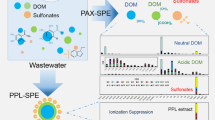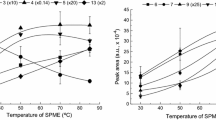Abstract
Matrix effects can significantly hamper the accuracy and precision of the analysis results of perfluorinated acids (PFAs) in environmental solid samples. Several methods, such as standard addition, isotopically labeled internal standards, clean-up of SPE (solid phase extraction) eluents by dispersive graphitized carbon sorbent and substitution of eletrospray ionization (ESI) source by atmosphere pressure photoionization (APPI) source, were demonstrated for elimination of matrix effects in quantitative analysis of PFAs in solid samples. The results indicate that matrix effects can be effectively eliminated by standard addition, but instrumental analysis time will be multiplied. Isotopically labeled internal standards can effectively negate matrix effects of PFAs with the same perfluorocarbon chain length, but is not valid for the other analytes. Although APPI can eliminate matrix effects for all analytes, it is only suitable for analysis of high pollution levels samples. Clean-up of SPE eluents by dispersive graphitized carbon sorbent not only effectively negate the impact of matrix effect, but also avoid frequent clean of the ESI in order to maintain instrumental sensitivity. Therefore, the best method for elimination of matrix effects is the usage of dispersive graphitized carbon sorbent for clean-up of SPE elution.
Similar content being viewed by others
References
KISSA E. Fluorinated surfactants and repellents [M]. New York: Marcel Dekker, Inc. 2001: 349–378.
HOUDE M, MARTIN J W, LETCHER R J, SOLOMON K R, MUIR D C G. Biological monitoring of polyfluoroalkyl substances: A review [J]. Environmental Science & Technology, 2006, 40(11): 3463–3473.
AHRENS L. Polyfluoroalkyl compounds in the aquatic environment: A review of their occurrence and fate [J]. Journal of Environmental Monitoring, 2011, 13(1): 20–31.
YOUNG C J, MABURY S A. Atmospheric perfluorinated acid precursors: Chemistry, occurrence, and impacts. WHITACRE D M, eds. Reviews of Environmental Contamination and Toxicology: Perfluorinated Alkylated Substances [M]. New York: Springer Science + Business Media. 2010: 1–109.
SMIT M, VAN HEERDEN P, PIENAAR J, WEISSFLOG L, STRASSER R, KRÜGER G. Effect of trifluoroacetate, a persistent degradation product of fluorinated hydrocarbons, on Phaseolus vulgaris and Zea mays [J]. Plant Physiology and Biochemistry, 2009, 47(7): 623–634.
HARDISTY J F, WILLSON G A, BROWN W R, MCCONMELL E E, FRAME S R, GAYLOR D W, KENNEDY G L, BUTENHOFF J L. Pathology working group review and evaluation of proliferative lesions of mammary gland tissues in female rats fed ammonium perfluorooctanoate (APFO) in the diet for 2 years [J]. Drug and Chemical Toxicology, 2010, 33(2): 131–137.
OLSEN G W, BUTENHOFF J L, ZOBEL L R. Perfluoroalkyl chemicals and human fetal development: An epidemiologic review with clinical and toxicological perspectives [J]. Reproductive Toxicology, 2009, 27(3/4): 212–230.
SUJA F, PRAMANIK B K, ZAIN S M. Contamination, bioaccumulation and toxic effects of perfluorinated chemicals (PFCs) in the water environment: A review paper [J]. Water Science and Technology, 2009, 60(6): 1533–1544.
CORSINI E, AVOGADRO A, GALBIATI V, DELL’AGLI M, MARINOVICH M, GALLI C L, GERMOLEC D R. In vitro evaluation of the immunotoxic potential of perfluorinated compounds (PFCs) [J]. Toxicology and Applied Pharmacology, 2011, 250(2): 108–116.
LUTHY R, AIKEN G, BRUSSEAN M, CUNNINGHAM S, GSCHWEND P, PIGNATELLO J, REINHARD M, TRAINA S, WEBER J W, WESTALL J. Sequestration of hydrophobic organic contaminants by geosorbents [J]. Environmental Science & Technology, 1997, 31(12): 3341–3347.
HIGGINS C P, LUTHY R G. Sorption of perfluorinated surfactants on sediments [J]. Environmental Science & Technology, 2006, 40(23): 7251–7256.
BERGER U, KAISER M A, KÄRRMAN A, BARBER J L, VAN LEEUWEN S P J. Recent developments in trace analysis of poly-and perfluoroalkyl substances [J]. Analytical and Bioanalytical Chemistry, 2011, 400(6): 1625–1635.
HIGGINS C P, FIELD J A, CRIDDLE C S, LUTHY R G. Quantitative determination of perfluorochemicals in sediments and domestic sludge [J]. Environmental Science & Technology, 2005, 39(11): 3946–3956.
LI F, ZHANG C, QU Y, CHEN J, CHEN L, LIU Y, ZHOU Q. Quantitative characterization of short- and long-chain perfluorinated acids in solid matrices in Shanghai, China [J]. Science of the Total Environment, 2010, 408(3): 617–623.
LI F, ZHANG C, QU Y, CHEN J, HU X, ZHOU Q. Method development for analysis of short- and long-chain perfluorinated acids in solid matrices [J]. International Journal of Environmental Analytical Chemistry, 2011, 91(12): 1117–1134
ZHANG T, SUN H W, GERECKE A C, KANNAN K, MULLER C E, ALDER A C. Comparison of two extraction methods for the analysis of per- and polyfluorinated chemicals in digested sewage sludge [J]. Journal of Chromatography A, 2010, 1217(31): 5026–5034.
POWLEY C R, GEORGE S W, RYAN T W, BUCK R C. Matrix effect-free analytical methods for determination of perfluorinated carboxylic acids in environmental matrixes [J]. Analytical Chemistry, 2005, 77(19): 6353–6358.
SINCLAIR E, KANNAN K. Mass loading and fate of perfluoroalkyl surfactants in wastewater treatment plants [J]. Environmental Science & Technology, 2006, 40(5): 1408–1414.
WASHINGTON J W, ELLINGTON J J, JENKINS T M, EVANS J J. Analysis of perfluorinated carboxylic acids in soils: Detection and quantitation issues at low concentrations [J]. Journal of Chromatography A, 2007, 1154(1/2): 111–120.
MARTIN J W, KANNAN K, BERGER U, DE VOOGT P, FIELD J, FRANKLIN J, GIESY J P, HARNER T, MUIR D C G, SCOTT B, KAISER M, JÄRNBERG U, JONES K C, MABURY S A, SCHROEDER H, SIMCIK M, SOTTANI C, VAN BAVEL B, KÄRRMAN A, LINDSTRÖM G, VAN LEEUWEN S. Analytical challenges hamper perfluoroalkyl research [J]. Environmental Science & Technology, 2004, 38(13): 248a–255a.
KING R, BONFIGLIO R, FERNANDEZ-METZLER C, MILLER-STEIN C, OLAH T. Mechanistic investigation of ionization suppression in electrospray ionization [J]. Journal of the American Society for Mass Spectrometry, 2000, 11(11): 942–950.
TAKINO M, DAISHIMA S, NAKAHARA T. Determination of perfluorooctane sulfonate in river water by liquid chromatography/atmospheric pressure photoionization mass spectrometry by automated on-line extraction using turbulent flow chromatography [J]. Rapid Communications In Mass Spectrometry, 2003, 17(5): 383–390.
KAUPPILA T J, KUURANNE T, MEURER E C, EBERLIN M N, KOTIAHO T, KOSTIAINEN R. Atmospheric pressure photoionization mass spectrometry. Ionization mechanism and the effect of solvent on the ionization of naphthalenes [J]. Analytical Chemistry, 2002, 74(21): 5470–5479.
CHU S, LETCHER R. Analysis of fluorotelomer alcohols and perfluorinated sulfonamides in biotic samples by liquid chromatography-atmospheric pressure photoionization mass spectrometry [J]. Journal of Chromatography A, 2008, 1215(1/2): 92–99.
LIEN G, CHEN C, WANG G. Comparison of electrospray ionization, atmospheric pressure chemical ionization and atmospheric pressure photoionization for determining estrogenic chemicals in water by liquid chromatography tandem mass spectrometry with chemical derivatizations [J]. Journal of Chromatography A, 2009, 1216(6): 956–966.
Author information
Authors and Affiliations
Corresponding author
Additional information
Foundation item: Projects(51108197, 51208215) supported by the National Natural Science Foundation of China; Projects(2011J05135, 2011J01318) supported by the Natural Science Foundation of Fujian Province, China; Project(11QZR08) supported by the Scientific Research Foundation of Overseas Chinese Affairs Office of the State Council, China; Project(10BS213) supported by the Scientific Research Foundation for Advanced Talents, Huaqiao University, China
Rights and permissions
About this article
Cite this article
Li, F., Zhao, Zl., Shen, Ch. et al. Elimination of matrix effects during analysis of perfluorinated acids in solid samples by liquid chromatography tandem mass spectrometry. J. Cent. South Univ. 19, 2886–2894 (2012). https://doi.org/10.1007/s11771-012-1355-0
Received:
Accepted:
Published:
Issue Date:
DOI: https://doi.org/10.1007/s11771-012-1355-0




